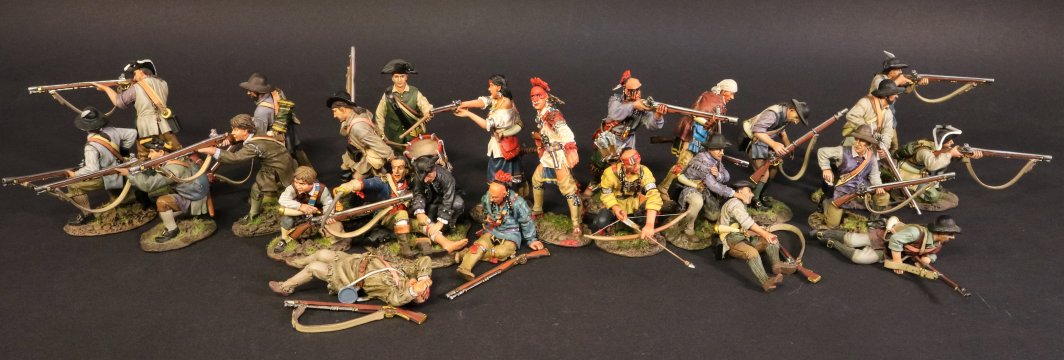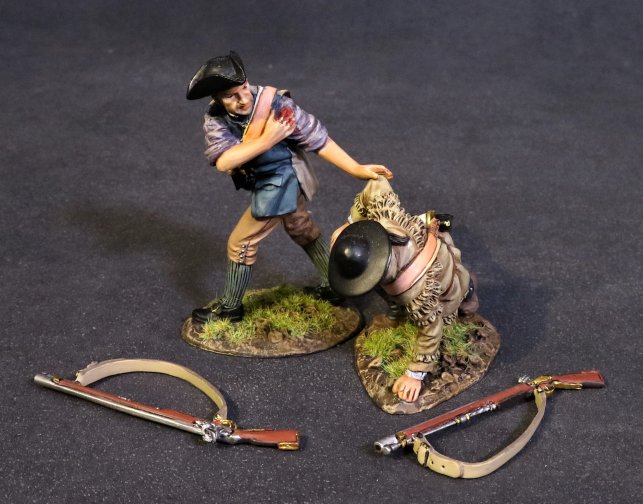- Joined
- Feb 2, 2011
- Messages
- 2,093
NEW RELEASES FOR OCTOBER 2021
THE EIGHTEENTH CENTURY COLLECTION
DRUMS ALONG THE MOHAWK
THE BATTLE OF ORISKANY, 1777.

The Battle of Oriskany on August 6, 1777 was one of the bloodiest battles in the American Revolutionary War and a significant engagement of the Saratoga campaign. A party of Loyalists and several Indian allies ambushed an American military party that was trying to relieve the siege of Fort Stanwix. This was one of the few battles in which almost all of the participants were Americans; Patriots and allied Oneidas fought against Loyalists and allied Iroquois in the absence of British regular soldiers.
The Patriot relief force came from the Mohawk Valley under General Nicholas Herkimer and numbered around 800 men of the Tryon County militia plus a party of Oneida warriors. British commander Barry St. Leger authorized an intercepting force consisting of a Hanau Jäger (light infantry) detachment, Sir John Johnson'sKing's Royal Regiment of New York, Indian allies from the Six Nations, particularly Mohawks and Senecas and other tribes to the north and west, and Indian Department Rangers, totaling at least 450 men.
The Loyalist and Indian force ambushed Herkimer's force in a small valley about six miles (10 km) east of Fort Stanwix, near the village of Oriskany, New York. Herkimer was mortally wounded, and the battle cost the Patriots approximately 450 casualties, while the Loyalists and Indians lost approximately 150 dead and wounded. The result of the battle remains ambiguous. The apparent Loyalist victory was significantly affected by a sortie from Fort Stanwix in which the Loyalist camps were sacked, damaging morale among the allied Indians.
The battle also marked the beginning of a war among the Iroquois, as Oneida warriors under Colonel Louis and Han Yerry allied with the American cause. Most of the other Iroquois tribes allied with the British, especially the Mohawks and Senecas.

DAM-17
DRUMS ALONG THE MOHAWK,
THE BATTLE OF ORISKANY, August 6[SUP]th[/SUP] 1777,
2 WOUNDED MILITIA.
(4 pcs)
In July and August 1775 Herkimer headed the Tryon County Committee of Safety, and became colonel of the district militia. After the split in which Loyalist militia members from the area withdrew to Canada, he was commissioned a brigadier general in the Tryon County militia by the Provincial Congress on September 5, 1776. In June 1776, he led 380 men of the Tryon County militia to confront Joseph Brant (Mohawk) at Unadilla, New York. Herkimer asked the Mohawk and five other Iroquois nations to remain neutral, while Brant said the Indians owed their loyalty to the King.
When Herkimer learned of the siege of Fort Stanwix to the west in late July 1777, he ordered the Tryon County militia to assemble at Fort Dayton. He marched them out to Fort Stanwix, about 28 miles to the west. His force marching in column was ambushed on August 6 by a mixed force of British regulars, Torymilitia, and Mohawk in the Battle of Oriskany. Herkimer's horse was shot, and he was seriously wounded in the leg. In spite of his injuries, he sat propped up against a tree, lit his pipe, and directed his men in the battle, rallying them to avoid two panicked retreats. When they withdrew, they carried him home.
The brigade surgeon, William Petrie, dressed Herkimer's wound in the field and placed him on a litter. The wound quickly became infected, but the decision to amputate the leg was delayed for about ten days after the battle. The operation was performed by an inexperienced surgeon, Robert Johnson, because Petrie had also been wounded in the battle and was not available. The operation went poorly, the wound bled profusely, and Herkimer died of the injury on August 16, at around the age of 49.
PLEASE CONTACT YOUR LOCAL DEALER FOR FURTHER INFORMATION
THE EIGHTEENTH CENTURY COLLECTION
DRUMS ALONG THE MOHAWK
THE BATTLE OF ORISKANY, 1777.

The Battle of Oriskany on August 6, 1777 was one of the bloodiest battles in the American Revolutionary War and a significant engagement of the Saratoga campaign. A party of Loyalists and several Indian allies ambushed an American military party that was trying to relieve the siege of Fort Stanwix. This was one of the few battles in which almost all of the participants were Americans; Patriots and allied Oneidas fought against Loyalists and allied Iroquois in the absence of British regular soldiers.
The Patriot relief force came from the Mohawk Valley under General Nicholas Herkimer and numbered around 800 men of the Tryon County militia plus a party of Oneida warriors. British commander Barry St. Leger authorized an intercepting force consisting of a Hanau Jäger (light infantry) detachment, Sir John Johnson'sKing's Royal Regiment of New York, Indian allies from the Six Nations, particularly Mohawks and Senecas and other tribes to the north and west, and Indian Department Rangers, totaling at least 450 men.
The Loyalist and Indian force ambushed Herkimer's force in a small valley about six miles (10 km) east of Fort Stanwix, near the village of Oriskany, New York. Herkimer was mortally wounded, and the battle cost the Patriots approximately 450 casualties, while the Loyalists and Indians lost approximately 150 dead and wounded. The result of the battle remains ambiguous. The apparent Loyalist victory was significantly affected by a sortie from Fort Stanwix in which the Loyalist camps were sacked, damaging morale among the allied Indians.
The battle also marked the beginning of a war among the Iroquois, as Oneida warriors under Colonel Louis and Han Yerry allied with the American cause. Most of the other Iroquois tribes allied with the British, especially the Mohawks and Senecas.

DAM-17
DRUMS ALONG THE MOHAWK,
THE BATTLE OF ORISKANY, August 6[SUP]th[/SUP] 1777,
2 WOUNDED MILITIA.
(4 pcs)
In July and August 1775 Herkimer headed the Tryon County Committee of Safety, and became colonel of the district militia. After the split in which Loyalist militia members from the area withdrew to Canada, he was commissioned a brigadier general in the Tryon County militia by the Provincial Congress on September 5, 1776. In June 1776, he led 380 men of the Tryon County militia to confront Joseph Brant (Mohawk) at Unadilla, New York. Herkimer asked the Mohawk and five other Iroquois nations to remain neutral, while Brant said the Indians owed their loyalty to the King.
When Herkimer learned of the siege of Fort Stanwix to the west in late July 1777, he ordered the Tryon County militia to assemble at Fort Dayton. He marched them out to Fort Stanwix, about 28 miles to the west. His force marching in column was ambushed on August 6 by a mixed force of British regulars, Torymilitia, and Mohawk in the Battle of Oriskany. Herkimer's horse was shot, and he was seriously wounded in the leg. In spite of his injuries, he sat propped up against a tree, lit his pipe, and directed his men in the battle, rallying them to avoid two panicked retreats. When they withdrew, they carried him home.
The brigade surgeon, William Petrie, dressed Herkimer's wound in the field and placed him on a litter. The wound quickly became infected, but the decision to amputate the leg was delayed for about ten days after the battle. The operation was performed by an inexperienced surgeon, Robert Johnson, because Petrie had also been wounded in the battle and was not available. The operation went poorly, the wound bled profusely, and Herkimer died of the injury on August 16, at around the age of 49.
PLEASE CONTACT YOUR LOCAL DEALER FOR FURTHER INFORMATION

